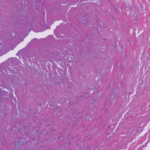
Tashatuvango/shutterstock.com
WASHINGTON, D.C.—From diagnosis questions to infection risk to treatment decisions, handling giant cell arteritis (GCA) and polymyalgia rheumatica (PMR) comes with a range of challenges for clinicians. Speaking in the ACR Review Course at the 2016 ACR/ARHP Annual Meeting, an expert—Rebecca Manno, MD, MHS, assistant professor of medicine in rheumatology at Johns Hopkins, as well as a fan of boating—likened the challenges to those faced by a boater: You have to remember to call things by the right name (definitions and classification criteria); beware of submerged objects (such as large-vessel vasculitis); be prepared for storms (venous thrombosis, infections and challenges with temporal artery biopsy); and use the right tools (therapies).
GCA, a systemic vasculitis of medium and large arteritis, is the most common form of vasculitis in Europe and North America. It affects women more than men, and older age and genetics are key risk factors. PMR, an inflammatory syndrome that targets the shoulder and hip girdle region, has similar demographics as GCA.
The two diseases are linked: Studies have shown that between 40 and 60% of those with GCA are also affected by PMR, and between 16 and 21% of those with PMR are affected by GCA.
Classification Criteria
The ACR classification criteria for GCA are 50 or older at onset; new headache; ESR of 50 mm/hour or higher; and abnormal temporal artery biopsy. They’ve been found to have 93.5% sensitivity and 91.2% specificity for GCA.
Provisional classification criteria for PMR, developed in 2012, are age 50 or older; bilateral shoulder aching and abnormal ESR or CRP plus morning stiffness of more than 45 minutes (2 points); hip pain or limited range of motion (1 point); absence of rheumatoid factor ACPA (2 points); and absence of other joint pain (1 point).
A score of 4 or greater has been found to have a sensitivity of just 68% and a specificity of 78%.
“The addition of ultrasound improved the specificity of these criteria,” Dr. Manno said. “However, it did not distinguish PMR [from] rheumatoid arthritis (RA).” She added that ultrasound was “very good” at identifying non-RA shoulder conditions and at discerning whether any shoulder condition was present at all.
A rapid response to steroids was not included in those criteria, but it still may be telling, she said.
“When you’re treating a patient, the lack of response to steroids may be a clue that you want to reclassify that patient as not having PMR,” she said.
Studies have shown that between 40 & 60% of those with GCA are also affected by PMR, & between 16 & 21% of those with PMR are affected by GCA.
Watching Out for Large-Vessel Vasculitis
A recent study comparing cranial GCA and large-vessel GCA found that patients with large-vessel GCA were older, had a longer time to diagnosis, were more likely to have a history of PMR, were far more likely (52 cases to 0) to have upper extremity claudication and were far less likely (95 to 32) to meet 3 or more of the ACR criteria for GCA.


